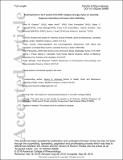Files in this item
Polymorphisms in the F pocket of HLA-B27 subtypes strongly affect assembly, chaperone interactions and heavy-chain misfolding
Item metadata
| dc.contributor.author | Guiliano, David B. | |
| dc.contributor.author | North, Helen | |
| dc.contributor.author | Panayoitou, Eleni | |
| dc.contributor.author | Campbell, Elaine C. | |
| dc.contributor.author | McHugh, Kirsty | |
| dc.contributor.author | Cooke, Fiona G. M. | |
| dc.contributor.author | Silvestre, Marine | |
| dc.contributor.author | Bowness, Paul | |
| dc.contributor.author | Powis, Simon J. | |
| dc.contributor.author | Antoniou, Antony N. | |
| dc.date.accessioned | 2018-02-28T00:32:57Z | |
| dc.date.available | 2018-02-28T00:32:57Z | |
| dc.date.issued | 2017-03 | |
| dc.identifier | 246678844 | |
| dc.identifier | 42b5cb5f-284c-4abf-ba0b-456ba7589134 | |
| dc.identifier | 85014084308 | |
| dc.identifier | 000395035100017 | |
| dc.identifier.citation | Guiliano , D B , North , H , Panayoitou , E , Campbell , E C , McHugh , K , Cooke , F G M , Silvestre , M , Bowness , P , Powis , S J & Antoniou , A N 2017 , ' Polymorphisms in the F pocket of HLA-B27 subtypes strongly affect assembly, chaperone interactions and heavy-chain misfolding ' , Arthritis & Rheumatology , vol. 69 , no. 3 , pp. 610-621 . https://doi.org/10.1002/art.39948 | en |
| dc.identifier.issn | 2326-5205 | |
| dc.identifier.other | Bibtex: urn:7355eebec6f5cf15c054999bf7a67427 | |
| dc.identifier.other | ORCID: /0000-0003-4218-2984/work/60195299 | |
| dc.identifier.uri | https://hdl.handle.net/10023/12812 | |
| dc.description | This work was in part funded by awards to Dr Antoniou (Arthritis Research UK Fellowship 15293) and Dr Powis (Scottish Government Chief Scientist Office ETM/56). | en |
| dc.description.abstract | Objective - HLA-B27 is associated with the inflammatory spondyloarthropathies (SpAs). Of significance, subtypes HLA-B*27:06 and HLA-B*27:09 are not associated with the SpAs. These subtypes primarily differ from the HLA-B*27:05 disease associated allele at residues 114 and 116 of the heavy chain, part of the F pocket of the antigen-binding groove. Dimerisation of HLA-B27 during assembly has been implicated in disease onset. This study investigated the factors influencing differences in dimerisation between disease associated and non-associated HLA-B27 alleles. Methods – HLA-B*27:05 and mutants resembling the HLA-B*27:06 and 09 subtypes were expressed in the rat C58 T cell line, the human CEM T cell line and its calnexin deficient variant CEM.NKR. Immunoprecipitation, pulse chase, flow cytometry and immunoblotting were performed to study the assembly kinetics, heavy chain dimerisation and chaperone associations. Results - By expressing HLA-B*27:05, 06-like and 09 alleles on a restrictive rat TAP peptide transporter background, we demonstrate that a tyrosine expressed at p116 or together with an aspartic acid residue at p114 inhibited HLA-B27 dimerisation and increased the assembly rate. F pocket residues alter the associations with chaperones of the early MHC class I folding pathway. Calnexin was demonstrated to participate in endoplasmic reticulum (ER) stress mediated degradation of dimers, whereas the oxidoreductase ERp57 does not appear to influence dimerization. Conclusion - Residues within the F pocket of the peptide-binding groove differing between disease-associated and non-disease-associated HLA-B27 subtypes can influence the assembly process and heavy chain dimerisation, events which have been linked to the initiation of disease pathogenesis. | |
| dc.format.extent | 12 | |
| dc.format.extent | 2031078 | |
| dc.language.iso | eng | |
| dc.relation.ispartof | Arthritis & Rheumatology | en |
| dc.subject | QH426 Genetics | en |
| dc.subject | R Medicine | en |
| dc.subject | NDAS | en |
| dc.subject | SDG 3 - Good Health and Well-being | en |
| dc.subject.lcc | QH426 | en |
| dc.subject.lcc | R | en |
| dc.title | Polymorphisms in the F pocket of HLA-B27 subtypes strongly affect assembly, chaperone interactions and heavy-chain misfolding | en |
| dc.type | Journal article | en |
| dc.contributor.institution | University of St Andrews. School of Medicine | en |
| dc.contributor.institution | University of St Andrews. Biomedical Sciences Research Complex | en |
| dc.contributor.institution | University of St Andrews. Cellular Medicine Division | en |
| dc.identifier.doi | https://doi.org/10.1002/art.39948 | |
| dc.description.status | Peer reviewed | en |
| dc.date.embargoedUntil | 2018-02-27 |
This item appears in the following Collection(s)
Items in the St Andrews Research Repository are protected by copyright, with all rights reserved, unless otherwise indicated.

